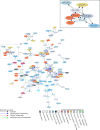Collating and Curating Neuroanatomical Nomenclatures: Principles and Use of the Brain Architecture Knowledge Management System (BAMS)
- PMID: 20407640
- PMCID: PMC2856634
- DOI: 10.3389/fninf.2010.00003
Collating and Curating Neuroanatomical Nomenclatures: Principles and Use of the Brain Architecture Knowledge Management System (BAMS)
Abstract
Terms used to describe nervous system parts and their interconnections are rife with synonyms, partial correspondences, and even homonyms, making effective scientific communication unnecessarily difficult. To address this problem a new Topological Relations schema for the Relations module of BAMS (Brain Architecture Knowledge Management System) was created. It includes a representation of the qualitative spatial relations between nervous system parts defined in different neuroanatomical nomenclatures or atlases and is general enough to record data and metadata from the literature, regardless of description level or species. Based on this foundation a Projections Translations inference engine was developed for the BAMS interface that automatically translates neuroanatomical projection (axonal inputs and outputs) reports across nomenclatures from translated information. To make BAMS more useful to the neuroscience community three things were done. First, we implemented a simple schema for validation of the translated neuroanatomical projections. Second, more than 1,000 topological relations between brain gray matter regions for the rat were inserted, along with associated details. Finally, a case study was performed to enter all historical or legacy published information about terminology related to one relatively complex gray matter region of the rat. The bed nuclei of the stria terminalis (BST) were chosen and 21 different nomenclatures from 1923 to present were collated, along with 284 terms for parts (gray matter differentiations), 360 qualitative topological relations between parts, and more than 7,000 details about spatial relations between parts, all of which was annotated with appropriate metadata. This information was used to construct a graphical "knowledge map" of relations used in the literature to describe subdivisions of the rat BST.
Keywords: data mining; databases; neuroanatomical projections; neuroanatomy; neuroinformatics.
Figures









References
-
- Alheid G. F., de Olmos J. S., Beltramino C. A. (1995). ‘Amygdala and extended amygdala,’ in The Rat Nervous System. 2nd Edn, ed. Paxinos G. (Amsterdam: Academic Press; ), 495–578
-
- Bleier R., Cohn P., Siggelkow I. R. (1979). ‘A cytoarchitectonic atlas of the hypothalamus and hypothalamic third ventricle of the rat,’ in Handbook of the Hypothalamus, eds. Morgane P. J., Panksepp J. (New York: Marcel Dekker; ). pp. 137–220
Grants and funding
LinkOut - more resources
Full Text Sources
Other Literature Sources

